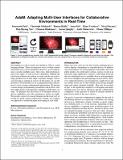Files in this item
AdaM : adapting multi-user interfaces for collaborative environments in real-time
Item metadata
| dc.contributor.author | Park, Seonwook | |
| dc.contributor.author | Gebhardt, Christoph | |
| dc.contributor.author | Rädle, Roman | |
| dc.contributor.author | Feit, Anna | |
| dc.contributor.author | Vrzakova, Hana | |
| dc.contributor.author | Dayama, Niraj | |
| dc.contributor.author | Yeo, Hui Shyong | |
| dc.contributor.author | Klokmose, Clemens | |
| dc.contributor.author | Quigley, Aaron John | |
| dc.contributor.author | Oulasvirta, Antti | |
| dc.contributor.author | Hilliges, Otmar | |
| dc.date.accessioned | 2018-04-21T23:33:45Z | |
| dc.date.available | 2018-04-21T23:33:45Z | |
| dc.date.issued | 2018-04-21 | |
| dc.identifier | 252010132 | |
| dc.identifier | 2d8de110-9127-458f-96f6-bbfe7a44f556 | |
| dc.identifier | 85046934807 | |
| dc.identifier | 000509673102028 | |
| dc.identifier.citation | Park , S , Gebhardt , C , Rädle , R , Feit , A , Vrzakova , H , Dayama , N , Yeo , H S , Klokmose , C , Quigley , A J , Oulasvirta , A & Hilliges , O 2018 , AdaM : adapting multi-user interfaces for collaborative environments in real-time . in Proceedings of the 2018 CHI Conference on Human Factors in Computing Systems (CHI'18) . , 184 , ACM , New York, NY , ACM CHI 2018 Conference on Human Factors in Computing Systems , Montréal , Canada , 21/04/18 . https://doi.org/10.1145/3173574.3173758 | en |
| dc.identifier.citation | conference | en |
| dc.identifier.isbn | 9781450356206 | |
| dc.identifier.other | ORCID: /0000-0002-5274-6889/work/43873409 | |
| dc.identifier.uri | https://hdl.handle.net/10023/13180 | |
| dc.description | This work was supported in part by ERC Grants OPTINT (StG2016-717054) and Computed (StG-2014-637991), SNF Grant (200021L 153644), the Aarhus University Research Foundation, the Innovation Fund Denmark (CIBIS 1311-00001B), and the Scottish Informatics and Computer Science Alliance (SICSA). | en |
| dc.description.abstract | Developing cross-device multi-user interfaces (UIs) is a challenging problem. There are numerous ways in which content and interactivity can be distributed. However, good solutions must consider multiple users, their roles, their preferences and access rights, as well as device capabilities. Manual and rule-based solutions are tedious to create and do not scale to larger problems nor do they adapt to dynamic changes, such as users leaving or joining an activity. In this paper, we cast the problem of UI distribution as an assignment problem and propose to solve it using combinatorial optimization. We present a mixed integer programming formulation which allows realtime applications in dynamically changing collaborative settings. It optimizes the allocation of UI elements based on device capabilities, user roles, preferences, and access rights. We present a proof-of-concept designer-in-the-loop tool, allowing for quick solution exploration. Finally, we compare our approach to traditional paper prototyping in a lab study. | |
| dc.format.extent | 14 | |
| dc.format.extent | 4180796 | |
| dc.language.iso | eng | |
| dc.publisher | ACM | |
| dc.relation.ispartof | Proceedings of the 2018 CHI Conference on Human Factors in Computing Systems (CHI'18) | en |
| dc.subject | Distributed User Interface | en |
| dc.subject | Cross-Device Interaction | en |
| dc.subject | UI adaptation | en |
| dc.subject | Optimization | en |
| dc.subject | QA76 Computer software | en |
| dc.subject | NDAS | en |
| dc.subject.lcc | QA76 | en |
| dc.title | AdaM : adapting multi-user interfaces for collaborative environments in real-time | en |
| dc.type | Conference item | en |
| dc.contributor.institution | University of St Andrews. School of Computer Science | en |
| dc.identifier.doi | https://doi.org/10.1145/3173574.3173758 | |
| dc.date.embargoedUntil | 2018-04-21 |
This item appears in the following Collection(s)
Items in the St Andrews Research Repository are protected by copyright, with all rights reserved, unless otherwise indicated.

